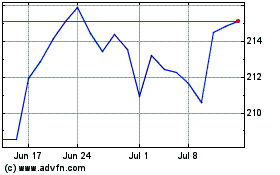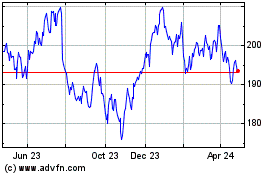Hazardous Airliner Landings Are Rare, Data Show, but Pilot Reporting Lags
November 25 2015 - 2:50PM
Dow Jones News
More than 200 landing approaches made by commercial airliners
over the past 15 years prompted cockpit emergency collision
warnings—the last possible alert before a crash—yet most of the
incidents weren't reported by pilots, according to global data
collected by Honeywell International Inc.
The hazardous approaches made up a minute portion of the more
than 20 million analyzed flights and none resulted in a crash, even
though some pilots pulled up at the last instant. But the numbers
indicate that premature descents and associated navigation errors,
which were the most common cause of crashes in previous decades,
haven't been eliminated, even as overall accident rates reach
record lows.
In recent years, onboard safety systems developed by Honeywell
and now made by several others have helped to largely eliminate
commercial accidents stemming from such cockpit slip-ups in Western
jets, experts inside and outside Honeywell say. The data, which
Honeywell says it hadn't previously disclosed partly to avoid
antagonizing pilot unions, don't break out specific airlines or
even regions where the hazardous incidents occurred.
Out of nearly 24.4 million flights between 2000 and 2015 that
Honeywell analyzed, the company found 224 so-called premature
descent events: when planes were heading for runways, but pilots
received computer-generated verbal warnings to "pull up, pull up."
Crews either adjusted their trajectories, or abandoned the
approaches.
The incidents "were mostly unreported by pilots or [air-traffic]
controllers," according to a summary document provided by the
company.
Pilot groups have "worked tirelessly with other industry bodies,
over many years, to address the challenges posed" by such
incidents, said Martin Chalk, president of the International
Federation of Air Line Pilots' Associations. He added that "under
reporting of significant events" remains a problem, which is "not
helped by either punitive or apathetic responses" from carriers or
regulators.
Nearly all of the dangerous approaches were flown without the
benefit of sophisticated ground-based navigation aids, like those
installed at major airports throughout the U.S., Europe and other
regions with mature aviation industries.
Many more such dangerous approaches are believed to occur than
are formally reported and investigated by government regulators or
safety agencies, veteran Honeywell safety expert Don Bateman
said.
Mr. Bateman, who in the 1990s led development of the advanced
safety devices—called enhanced ground-proximity warning
systems—said in an interview that "pilots tend to very quickly
recover" when they get such a dramatic warning on approach. "They
get the heck out of there, in a hurry."
Robert Francis, a former vice chairman of the U.S. National
Transportation Safety Board, said the data "absolutely represents a
tribute to the system" of safety technologies provided by various
suppliers. "It shows things are working" as intended, he said, "and
flight crews are trained to react almost instantaneously."
A decade ago, "controlled flight into terrain" accidents—when
pilots lose track of their location or surroundings—accounted for
25% of fatal commercial crashes. In 2014, they accounted for
roughly 2% of all accidents and about 13% of fatalities world-wide,
according to statistics assembled by the aviation arm of the United
Nations. The lifesaving technology is installed on more than 55,000
commercial and military aircraft.
Honeywell gathers incident data whenever ground-collision
warning devices are returned for service, upgrade or repair.
"Most pilots don't realize the data is there" to be harvested,
Mr. Bateman said. Honeywell says it has gone to great lengths to
reassure pilot unions that their goal isn't to identify or punish
crews that made mistakes.
Over the years, Honeywell has used the information to revise
databases by correcting errors involving terrain features, as well
as adjusting the height and position of other natural and man-made
obstacles shown in navigation systems. More recently, the data have
been used to document safety trends and to show that timely
warnings—combined with enhanced awareness and simulator training
for pilots—can prevent deadly crashes.
Write to Andy Pasztor at andy.pasztor@wsj.com
Subscribe to WSJ: http://online.wsj.com?mod=djnwires
(END) Dow Jones Newswires
November 25, 2015 14:35 ET (19:35 GMT)
Copyright (c) 2015 Dow Jones & Company, Inc.
Honeywell (NASDAQ:HON)
Historical Stock Chart
From Mar 2024 to Apr 2024

Honeywell (NASDAQ:HON)
Historical Stock Chart
From Apr 2023 to Apr 2024
